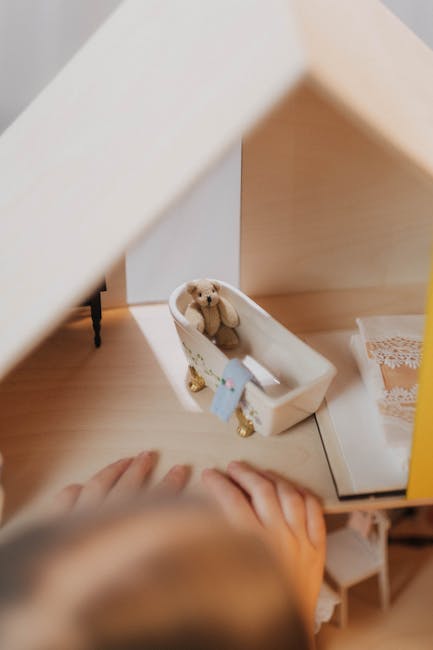How to Turn Everyday Objects into Fun DIY Toys
In a world overflowing with digital entertainment, there’s a unique charm in creating something tangible and fun with your own hands. 🎨 Transforming everyday objects into delightful DIY toys not only sparks creativity but also offers a sustainable way to repurpose items that might otherwise end up in the trash. Whether you’re looking to entertain your kids or simply enjoy a crafty afternoon, this guide is for you. Let’s dive into how you can turn ordinary household items into extraordinary playthings!
Table of Contents
1. Introduction
2. The Benefits of DIY Toys
3. Gathering Your Materials
4. Creative DIY Toy Projects
a. Sock Puppets 🧦
b. Cardboard Castles 🏰
c. Bottle Rockets 🚀
d. Paper Mâché Animals 🐘
5. Conclusion
6. FAQ
Introduction
Creating DIY toys from everyday objects is a fantastic way to engage children and adults alike in hands-on learning and creative play. This activity not only fosters imagination but also teaches problem-solving skills and sustainability. So whether it’s a rainy day or you’re just in the mood for some crafting, these projects are sure to bring smiles and satisfaction.
The Benefits of DIY Toys
DIY toys offer myriad benefits, both for personal development and the environment:
1. Creativity Boost: Crafting toys encourages creative thinking and artistic expression. 🌟
2. Environmental Impact: Repurposing materials reduces waste, promoting a more sustainable lifestyle. 🌍
3. Cost-Effective: DIY toys are budget-friendly, saving money while providing hours of fun. 💰
Gathering Your Materials
You likely have everything you need around the house to start creating DIY toys. Here’s a quick checklist:
🧦 Old socks
📦 Cardboard boxes
🔧 Plastic bottles
📰 Old newspapers
✂️ Scissors and glue
🎨 Paints and brushes
Before starting any project, ensure your materials are clean and safe for use, especially if young children are involved.
Creative DIY Toy Projects
Sock Puppets 🧦
Sock puppets are a classic DIY toy that can create endless entertainment and storytelling possibilities.
Materials Needed: Old socks, buttons, yarn, glue, and markers.
Steps:
1. Turn the sock inside out and sew or glue on buttons for eyes.
2. Use yarn to make hair and attach it to the sock’s top.
3. Decorate with markers to add unique features like a mouth or freckles.
4. Bring your sock puppet to life with a fun voice and personality! 🎤
Cardboard Castles 🏰
With just a few cardboard boxes, you can create a majestic castle for knights and princesses to roam.
Materials Needed: Cardboard boxes, scissors, paint, and tape.
Steps:
1. Break down the boxes and cut out castle walls, towers, and gates.
2. Use tape to assemble the pieces into your desired castle shape.
3. Paint the castle with vibrant colors or realistic stone textures.
4. Add flags, drawbridges, and other creative elements. 🏇
Bottle Rockets 🚀
For a more science-focused project, create bottle rockets that can soar into the sky!
Materials Needed: Plastic bottles, vinegar, baking soda, and a cork.
Steps:
1. Fill a quarter of the bottle with vinegar.
2. Wrap baking soda in a small piece of paper and place it inside the bottle.
3. Quickly seal the bottle with the cork and stand back.
4. Watch as your rocket blasts off! (Adult supervision recommended) 🚀
Paper Mâché Animals 🐘
Create adorable paper mâché animals using old newspapers and a little creativity.
Materials Needed: Newspapers, flour, water, and paint.
Steps:
1. Mix flour and water to create a paste.
2. Dip strips of newspaper in the paste and layer them over a balloon or mold.
3. Allow it to dry completely before popping the balloon and removing the mold.
4. Paint your animal with colorful designs and add details like eyes and whiskers. 🎨
Conclusion
Transforming everyday objects into DIY toys is not just an enjoyable pastime but also an educational and eco-friendly activity. By engaging in these projects, you can foster creativity, save money, and help the environment. So gather your materials, let your imagination run wild, and enjoy the endless possibilities of DIY toys!
FAQ
1. What age group is suitable for these DIY projects?
These DIY projects are adaptable for a wide range of ages. Younger children may need adult supervision, especially for cutting and assembling, while older kids and adults can enjoy more complex projects.
2. How can DIY toys benefit children’s development?
DIY toys encourage creativity, problem-solving, and fine motor skills. They also teach children about recycling and the value of creating something with their own hands.
3. What should I do if I don’t have all the materials listed?
Feel free to get creative and substitute materials with what you have on hand. The essence of DIY is improvisation and innovation, so don’t hesitate to experiment!
4. Are these projects safe for kids?
Yes, these projects are generally safe, but adult supervision is recommended, particularly when using scissors, glue, or small parts.
5. Can these projects be used as educational tools?
Absolutely! These projects can be integrated into lessons about science, art, and sustainability, making learning fun and interactive.
